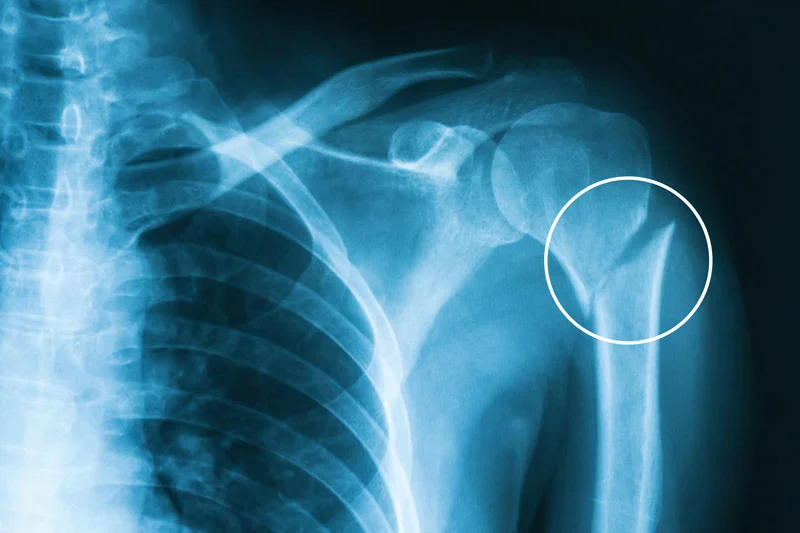A proximal humerus fracture is a break in the upper part of the arm bone, just below the shoulder. This type of fracture can be very painful and may make it difficult to move your arm. In some cases, surgery may be necessary to repair the bone. In this blog post, we will discuss the symptoms, causes, and treatment options for proximal humerus fractures.
Contents
What Is Proximal Humerus Fracture?

A proximal humerus fracture is a break in the bone near the shoulder joint. The proximal humerus is the upper part of the long bone in the arm that fits into the socket of the shoulder joint. This type of fracture can range from a small crack to a complete break in two pieces.
Symptoms
There are various symptoms of proximal humerus fracture. They are as follows:
1. Severe pain in the shoulder or upper arm: The pain is caused by damage to the bones, muscles, tendons, and ligaments around the shoulder.
2. Difficulty in moving the arm: You will have difficulty in moving your arm if the fracture is severe. This is because the bones are not able to support the weight of the arm properly.
3. Swelling and bruising around the affected area: Swelling and bruising are common symptoms of a proximal humerus fracture. The swelling may make it difficult to move the arm, and the bruise may be tender to the touch.
4. Tenderness in the damaged area: You will feel pain and tenderness when someone touches the outer upper arm or presses on it.
5. Deformity in the shape of the arm: The arm may appear shorter than the other arm, and the shoulder may droop.
6. Inability to move the arm: You will not be able to lift your arm away from your side or overhead.
7. Weakness in the arm: You may feel weak when you try to lift or move your arm.
Causes
There are various causes for proximal humerus fracture. They are as follows:
Trauma
A direct blow to the shoulder region can cause a proximal humerus fracture. This is usually seen in car accidents or falls from a height. For example, if you fall while skiing and land on your shoulder, the force of the impact can cause a proximal humerus fracture.
Osteoporosis
Osteoporosis is a condition that leads to thinning and weakening of bones. This makes them more susceptible to fractures. Proximal humerus fractures are seen more often in older adults who have osteoporosis.For example , a fall from a standing height may not cause a fracture in someone with strong bones, but can easily cause a fracture in someone with osteoporosis.
Cancer
Metastatic cancer can cause a proximal humerus fracture when the cancerous cells weaken the bone. For instance, breast cancer and prostate cancer are common causes of bone metastasis that can lead to a proximal humerus fracture. Benign or malignant tumors in the bone can cause a proximal humerus fracture. For example, osteosarcoma is a type of cancer that begins in the bone. It can cause the bone to weaken and break.
Infection
An infection in the bone can also lead to a proximal humerus fracture.For example, osteomyelitis is a condition where bacteria infect the bone. This can happen after an injury or surgery near the shoulder. Other risk factors for osteomyelitis include:
- Diabetes
- Use of intravenous drugs
- Poor circulation
Diagnose
There are various methods through which it can diagnose. They are as follows:
X-Ray: It is the most common and essential method to diagnose this condition. An x-ray can show the break in the bone.
Computed Tomography (CT) Scan: It creates a 3-dimensional image of the internal structures, which helps to detect any subtle fractures.
Magnetic Resonance Imaging (MRI): It is used to check the damage to the surrounding muscles, tendons, and ligaments.
Treatment Options

The treatment options available for a proximal humerus fracture are as follows:
Non-surgical Treatment
The doctor may recommend this treatment option if the break is not severe. The doctor will put the arm in a sling or splint to immobilize it. This will help the bone heal properly. Pain medication may also be prescribed to relieve pain and inflammation.
Surgical Treatment
The doctor may recommend surgery if the break is severe or if non-surgical treatment options have not worked. Surgery may involve the use of metal plates, screws, and/or pins to hold the bone in place. A joint replacement may also be necessary.
After the initial treatment has been completed, physical therapy may be recommended to help regain strength and range of motion in the arm.
Proximal humerus fractures can be difficult to treat due to the location of the injury. It is important to follow the doctor’s recommendations for treatment to ensure proper healing.
Prevention
The proximal humerus fracture can be prevented by the following:
- Wearing a seatbelt while driving
- Using pads or helmets during contact sports
- Avoiding falls by using guardrails or other support when climbing
- Treating osteoporosis to prevent bone weakening and fractures
How Can A Physical Therapist Help?
A Physical therapist will help proximal humerus fracture. It includes as follows:
1. Controlling the pain: A physical therapist will use different techniques to help control your pain. These can include ice, heat, and electrical stimulation. They may also teach you exercises that can help reduce your pain.
2. Restoring motion: Once the pain has decreased, a physical therapist will work on restoring your range of motion.
3. Restoring strength: A physical therapist will also work on restoring the strength in your arm. This will be done through a variety of exercises that focus on different muscle groups.
4. Preventing re-injury: Once you have fully recovered from your proximal humerus fracture, a physical therapist can help you prevent re-injury. They will do this by teaching you how to properly use your arm and by strengthening the muscles around your shoulder.
5. Improving function: A physical therapist can also help you improve your overall function. They will do this by teaching you how to properly use your arm and by helping you regain your strength.
A physical therapist can help you recover from a proximal humerus fracture and improve your overall function. They will do this by controlling your pain, restoring your motion, and preventing re-injury.
These are done with the help of various treatments like manual therapy, exercises, electrical stimulation, and others.
- Manual therapy: This is a type of therapy that uses the hands to manipulate the soft tissues and joints. This can help to reduce pain and swelling and improve the range of motion.
- Exercises: exercises are an important part of physical therapy. They help to strengthen the muscles around your shoulder and improve your range of motion.
- Electrical stimulation: This is a treatment that uses electrical currents to help reduce pain and swelling.
- Heat or ice: Heat or ice can be used to help reduce pain and swelling.
Conclusion
It may be concluded that a proximal humerus fracture is a serious injury that requires diagnosis and treatment by a medical professional. The most common symptom of this condition is a pain in the shoulder area. It is necessary to talk to a doctor if you think you may have a proximal humerus fracture. Early diagnosis and treatment are necessary to avoid any complications.
Physical Therapy help patients recover from pain. If you’re experiencing Back pain, Shoulder pain, Knee pain, Neck pain, Elbow pain, Hip pain, or Arthritis pain, a physical therapist at MantraCare can help: Book a physiotherapy session.


